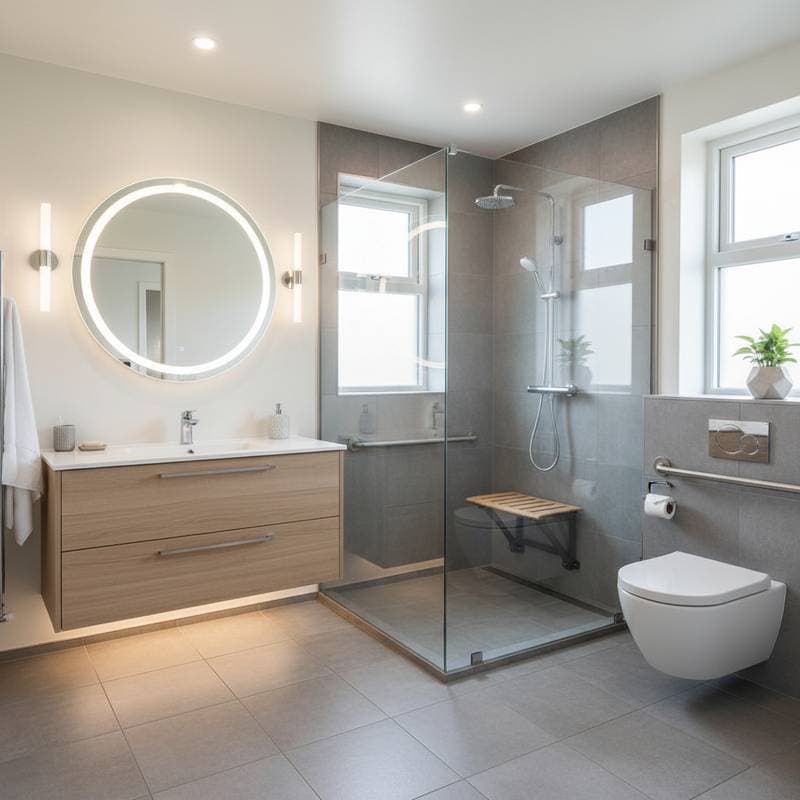Wet Rooms: Transforming Modern Bathrooms Beyond Traditional Showers
Homeowners increasingly select open, barrier-free wet rooms over conventional shower enclosures. A well-executed wet room expands the sense of space, enhances cleanliness, and improves accessibility. Poor implementation, however, results in water damage, hazardous slippery surfaces, and substantial repair costs. Experienced professionals recognize that success depends on thorough planning, impeccable waterproofing, and precise construction. A wet room functions as an integrated system designed to withstand regular exposure to moisture.
Key Reasons Homeowners Opt for Wet Rooms
The primary attraction of a wet room lies in its streamlined design. Rather than installing framed showers or prefabricated bases, the entire area becomes a sealed, waterproof environment with uniform flooring and an unobstructed shower zone. This approach yields a contemporary aesthetic that optimizes available space, particularly in compact bathrooms where enclosures often create a confined feel.
Accessibility represents a significant advantage as well. Without curbs or thresholds, entry proves simpler for individuals facing mobility limitations. Cleaning becomes efficient, as no door tracks or enclosures require detailed scrubbing. When constructed properly, the flooring directs water effectively to drains, allowing surfaces to rinse with ease and minimal residue.
Risks Associated with Substandard Construction
Despite their straightforward appearance, wet rooms demand rigorous building techniques. Water infiltration poses the greatest hazard. Incorrect floor gradients or inadequate waterproofing membranes permit moisture to penetrate beneath tiles and into structural elements. Such issues progress undetected, eventually causing tiles to detach or finishes to blister in adjacent areas. Professionals frequently address failures in installations mere months after completion due to overlooked procedures.
Inadequate ventilation presents another frequent oversight. With the full space exposed to water, condensation accumulates readily. Insufficient air circulation allows humidity to persist, fostering mold development and persistent odors. A robust, continuously operable exhaust fan forms an essential component of the overall setup.
Step-by-Step Guide to Constructing a Dependable Wet Room
Achieving reliability requires a systematic process. The following outline details the proven sequence employed by skilled installers.
-
Develop a precise layout plan. Select a position that facilitates effective drainage. Position the shower zone away from the entrance and proximate to existing plumbing lines where feasible. Consider spray patterns and water flow paths to ensure unobstructed movement toward the drain.
-
Strengthen the subfloor foundation. Wet rooms necessitate a stable substrate. Subfloors that flex or lack uniformity risk cracking tiles and compromising waterproof layers. Install cement board or a fortified mortar bed to provide the required support prior to applying membranes.
-
Incorporate a high-performance drain assembly. Linear drains offer a minimalist profile and support unidirectional slopes for even water evacuation. Traditional round drains suit various configurations, provided the floor inclines uniformly from all directions. Maintain a slope of at least one-quarter inch per linear foot to promote swift drainage.
-
Deploy a comprehensive waterproofing membrane. This phase distinguishes expert work from novice efforts. Apply a tanking solution across the complete floor surface, extending several inches upward along all walls. Reinforce junctions with specialized tape and conduct a leak test by flooding the area before proceeding to tiling.
-
Select appropriate tiles and grout materials. Opt for smaller-format floor tiles to maintain consistent gradients. Prioritize textured, slip-resistant finishes to minimize accident risks. Epoxy-based grouts outperform cement varieties in wet environments, resisting degradation and ensuring longevity.
-
Integrate effective ventilation solutions. Equip the space with a premium exhaust fan featuring timer controls or humidity detection. Ensure the unit exchanges sufficient air volume to eliminate moisture rapidly following use.
-
Incorporate functional accessories. Utilize wall-mounted fixtures and storage units to preserve clear surfaces. A partial glass panel may direct spray without enclosing the area, balancing openness with practicality.
Evaluating Costs and Long-Term Value
Constructing a wet room generally incurs higher expenses than a conventional shower, owing to specialized waterproofing products and exacting labor. The benefits include superior endurance and simplified upkeep. Remedying leaks in a flawed installation often surpasses the premium for quality materials and methods. For those intending long-term occupancy, this initial outlay yields returns through dependable performance and user comfort.
In terms of property value, a expertly crafted wet room enhances marketability, appealing to purchasers desiring contemporary and inclusive features. Conversely, evident flaws deter interest. Building inspectors readily identify drainage deficiencies or moisture intrusion. Retain records from the installer detailing the waterproofing methodology to substantiate quality.
Fostering Clear Communication with Contractors
Many wet room issues stem from unclear expectations. Homeowners might interpret waterproofing as infallible, whereas contractors could view open designs as requiring less reinforcement. Document all specifications in writing, covering membrane types, drainage configurations, ventilation strategies, and finishing products. Request a flood test on the sealed floor prior to tiling to verify integrity and safeguard the project.
Contractors must convey that waterproofing demands time for curing. Hastening drying or tiling stages invites complications. This emphasis on diligence averts future disruptions and ensures satisfaction.
Sustaining Your Wet Room Over Time
Post-installation care remains simple yet vital. Regularly clear drains of debris and inspect for grout erosion or tile shifts. Activate the exhaust fan consistently after showers to dispel excess humidity. Steer clear of abrasive cleaners that might erode protective coatings. Diligent upkeep enables a quality wet room to endure for decades with minimal intervention.
A wet room reimagines the bathroom as a cohesive, expansive haven blending luxury with utility. Prioritizing waterproofing as the foundational element elevates it beyond mere aesthetics. This balanced approach delivers a space that operates seamlessly, exudes sophistication, and remains resilient through years of use.










